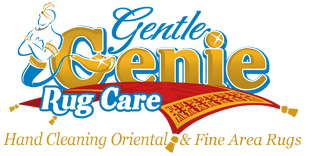
We love our pets. And they love us. But accidents happen, and sometimes their instincts don’t mesh well with rugs and furniture. In discussing various types of pet damage and what to do about them it’s important to keep in mind that there are important differences between fine rugs and wall-to-wall carpet. Always make sure that any tips or instructions you might follow are for the your specific type of rug, not a carpet.
Physical Pet Damage
When cats and dogs scratch, claw, and “dig,” their claws often catch and can pull out threads or even cut fibers. That’s actually less of an issue with rugs than carpet. Carpets are generally constructed with loops of fiber whereas rugs are not. (Berber rugs are a notable exception.) With no loops to catch it’s likely that just the direction of the pile has been messed up. In that case a little grooming (misting an brushing) can correct the problem. If there’s been real damage it may be possible to re-trim fibers to the right length or even move fibers from elsewhere to damaged areas.
The more you treasure the rug the more important it is to have a professional assessment before taking any actions. They may be able to make a rescue repair. Or given special provenance or historic value it may be best to live with the damage. But in general you should repair damage to oriental rugs and other fine rugs.
Stains and Smells
Pet accidents should be treated immediately as contamination quickly soaks into natural fibers and soon becomes trapped. But before going beyond basic cleaning use only products specifically made for the types of fibers in your rug. And test a small inconspicuous area for color fastness and water tolerance.
[blockquote quote=”Special Note: Artificial silk (such as art silk, bamboo silk, banana silk, Tencel, and Vicose) are cellulose-based with heavy chemical processing. Wet spills are a disaster so you need to take special precautions. And read their specific care instructions in advance of any spills or accidents.” align=”none” style=”default”]
Five Basic Steps for Urine and Worse
Here’s an outline of the key things you need to do as soon as possible after a problem occurs. If they don’t fully resolve the issues then professional services are in order. The next section summarizes the different steps for wool and silk rugs.
- For urine, blot up as much liquid and dampness as you can with a white or light-colored towel. If poop, remove it using a paper towel or disposable gloves. Diarrhea is a special case. Let it dry first, then wearing disposable gloves remove as much as you can.
- It’s also important to disinfect, but extra caution is in order. You may be able to use a common product such as Lysol (test first!) or a product special-made for carpet. Never anything containing bleach or ammonia.
- Clean the area with a solution of mild dish soap or laundry detergent. Be sure there’s no bleaching agents or fragrances. Don’t soak the area — just dab and blot. Stop immediately if you see any rug dye moving into the towel.
- Press dry, and then let air for a while. Vacuum once thoroughly dry.
- Repeat cleaning, drying, and vacuuming as necessary.
If odors remain it’s best to keep repeating the cleaning procedure. But if odors are set in you might try cleaning with a mixture of white vinegar and water (about 1 tablespoon of vinegar per 1 or 2 cups water). Or sprinkle baking soda over the area, let it sit all day or all night, then vacuum. But as always test a small out-of-the-way area first.
In some situations if may be possible to use an enzymatic cleaner. That typically involves application, blotting a way most of the solution, letting sit for 48 hours, then vacuuming.
[blockquote quote=”Note: If urine or other contamination has soaked through to the backside of the rug only professional immersion cleaning can make sure that all deep-down contamination has been removed and that odors have been permanently eliminated.” align=”none” style=”default”]
[blockquote quote=”Also Note: Don’t forget to clean the floor underneath. It should also be disinfected, and may need odor removal and sealing.” align=”none” style=”default”]
Special Steps for Pet Damage to Special Rugs
For wool rugs, blot and scoop. But then clean with soda water (or one part vinegar with three parts cool filtered water), dampening the area then blotting away contamination using a white or light-colored towel. It’s important to blot, not scrub. Repeat until the towel remains clean. Then press to squeeze out moisture. Let air dry, then vacuum.
For silk rugs blot and scoop, then pack with cornstarch and call in a professional rug cleaner.
Pet Accidents Recent Projects
Here are some recent examples of treasured rugs we have helped save from pet damage.
- Large-area pet odor and stain removal using a submersion bath.
- Immediate flushing urine from a wool rug, also using full immersion.
- Urine decontamination for a treasured Tabriz oriental rug.
- Many hours spent eliminating dog urine from an antique braided wool rug.
